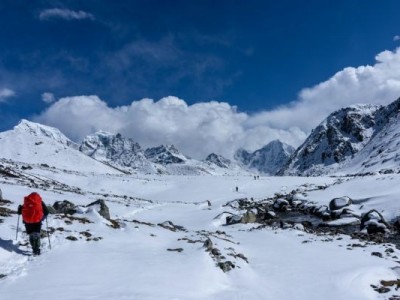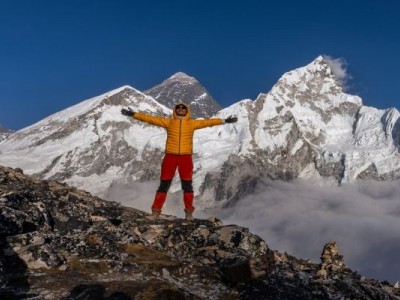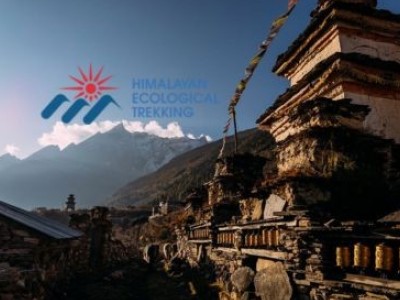Why Trek Langtang Valley in Winter?
Winter is one of Nepal's most beautiful and underrated trekking experiences in the Langtang Valley. While trekkers flock to the Everest and Annapurna regions of the country during peak seasons, this breathtaking valley, located close to the Tibetan border, offers you something truly special: access to beautiful snow-covered landscapes, sincere Tamang culture, and stunning mountain vistas without being overrun by the crowds that descend on Everest or Annapurna.
Just north of Kathmandu, on this winter trek in the Langtang region, you will trek through lovely rhododendron forests, local villages that were rebuilt after the 2015 earthquake, and winter wonderland alpine meadows. The Langtang Valley has a manageable altitude of 3,800-4,984m, which makes it accessible to trekkers who want to immerse themselves in the beauty of winter trekking without the technical challenges of extreme altitude.
Among the many spectacular highlights are the panoramic views from Kyanjin Ri (4,773m) or Tserko Ri (4,984m). On a clear winter morning, you can witness an unbelievable sunrise over Langtang Lirung (7,227m), and a myriad of other spectacular mountains, including Ganesh Himal, Dorje Lakpa, and the Langtang range. The winter visibility is often spectacular, which usually means a crystal-clear view of the mountains that photographers and nature lovers dream of.
The trek will generally take between 7 to 10 days, depending on your pace and side trips, and it's moderately difficult. It is suited for adventurous beginners or seasoned trekkers. Winter offers a magical experience with snow-dusted trails and crisp mountain air, and with the proper preparations and guidance from Himalayan Ecological Trekking, the route is usually reasonably safe to travel. And not to forget, the warmth of Tamang hospitality in mountain lodges will leave you with unforgettable memories.
Langtang Valley Trek in December
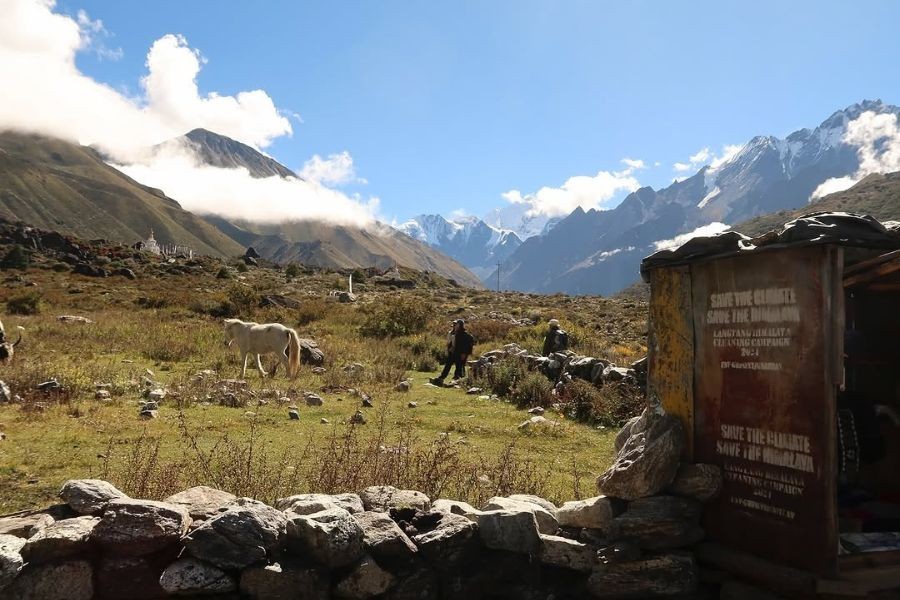
Although Langtang is accessible all year long, the optimal time for clear skies and less crowded trails is during winter (December through February), save for the Langtang Valley trek in December, which is the experience of a lifetime.
As early winter settles in, the first larger snowfalls blanket the valley, completely transforming it into a bright white wonderland. The air is exceptionally crisp and clean, and on most days, the skies remain clear for several days in a row, providing some of the best mountain views in Nepal. From Kyanjin Gompa or any viewpoint nearby, the entire Langtang range radiates under the winter sun.
December is particularly meaningful in these mountain communities. Even though there are fewer trekkers than in autumn's peak season, the Tamang and Sherpa villages are still lively, warmly welcoming visitors. You can see glimpses into winter preparations for local festivals, the prospective rituals in ancient monasteries, and the everyday cycles of mountain life that persist even in the biting cold. The dry mountain air is filled with scents of juniper incense, and if you're near a village, wood smoke—and the air holds remnants of history, creating the timelessness of mountains and ancient places.
Even when temperatures can drop to approximately –15°C at higher altitudes at night, the days are generally warm and sunny for trekking. With the right winter gear and guidance from Himalayan Ecological Trekking's knowledgeable guides, December is a great time for adventurers looking to experience this astonishing valley. This trip showcases an amazing mix of natural beauty, cultural authenticity, and enjoyable solitude.
Langtang Valley Trek in January
To trek the Langtang Valley in January is to experience the greatest snow and the quietest trails imaginable, any time of year. January is the coldest month in the Himalayas, and although hard to fathom, it is indeed one of the most fulfilling months to witness the region in its purest, most untouched state. The entire valley will feel like a frozen cathedral—serene, sacred, and unbelievably gorgeous.
If you're the sort of trekkers who want to be alone and gaze upon untouched beauty in nature, then look no further: January is perfect. You will nearly have the trails all to yourself, and you'll have all the time you need to drink it in, and surround yourself with nature, and feel one with it. The mountain views are still spectacular—in fact, on clear mornings, the entire Langtang range appeared so close you'd think you could reach out and touch it. Nothing could compare, particularly the shocking contrast of brilliant blue skies, with peaks entirely covered in a heavy snow blanket, and the surreal scenery, which was unbelievably beautiful, and represented an escape from the city's noise and hassle.
Langtang Valley experiences a whole different world in January. Smoke rises from chimneys, families gather around wood stoves, and you will likely receive authentic mountain hospitality in delightful teahouses! The Kyanjin Gompa monastery is a tranquil refuge where monks continue their daily prayer rituals despite the harsh environment. You may even observe yaks blissfully shampooing through the snow, their breath visible in the cold air.
January trekking does involve some serious preparation for cold weather; nevertheless, it is still safe and feasible with the proper clothing, right gear, and guidance from an experienced team such as Himalayan Ecological Trekking. Warm lodges, hot meals, and cozy blankets await you at the end of each day. If you desire to experience a classic winter trek amidst tranquility, white-silver snow landscapes, and breathtaking scenery, then Langtang Valley in January will not disappoint.
Langtang Valley Trek in February
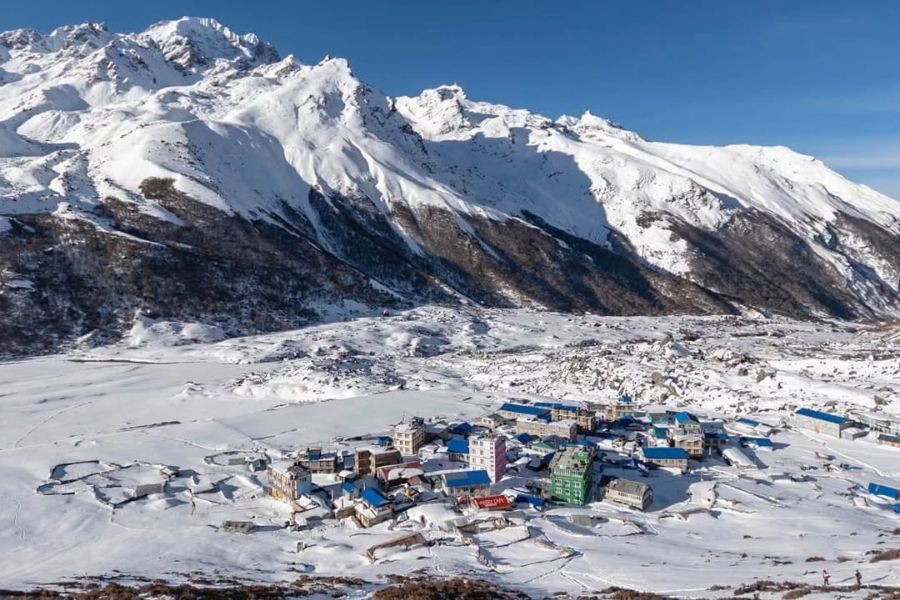
The Langtang Valley trek in February represents the lovely shift from deep winter to early spring in the mountain regions of Nepal. As winter slowly fades, days get longer and warmer, making it more enjoyable for those who like less intense winters. Snow persists at the higher elevations around Kyanjin Gompa and the viewpoints, but the lower elevations of the trek are beginning to show early signs of life.
February caters to the best of both worlds: the snowy magic of winter, plus the bright, refreshing hint of spring around the corner. The sky is mostly clear, allowing uninterrupted viewing of the Langtang range of mountains. Whether viewing from Kyanjin Ri or Tserko Ri, the epic view of Langtang Lirung and the surrounding peaks is just as magnificent as in December or January, yet with a slightly softer light that works great for photography.
More festive activities in and around the village start to take on life. There's a little more energy than January's stillness, but the trails still seem perfectly peaceful and quiet. Local families have begun prepping their fields for spring, and children can still be seen playing in the last of the winter snow. The tea houses become lively with trekkers and locals sharing tales around the fire.
You can have a well-balanced adventure that includes beauty in nature, culture, and even some decent weather with the attentive & experienced team at Himalayan Ecological Trekking! February is a great time to have a final winter trekking experience in the Himalayas!
Breathtaking Mountain Views & Alpine Landscapes
One of the best reasons to travel to the Langtang Valley in the Winter is the simply stunning mountain scenery that is at your doorstep. The valley gives you intimate views of some of the best mountains in Nepal without needing extreme altitude or technical climbing.
From Kyanjin Gompa (3870 meters), you can look straight at Langtang Lirung (7227 meters), which entirely dominates the valley with its colossal ice-clad face. The mountain appears so close in the crisp, clear winter air that you can actually see glaciers and ice formations. For a more incredible view, consider hiking above Kyanjin Gompa to Kyanjin Ri (4773 meters) or even (if you're up for it) to Tserko Ri (4984 meters) for a sunrise view.
The different viewpoints provide 360-degree views that take in Langtang Lirung, Langtang II, Dorje Lakpa, Yala Peak, Naya Kanga, in addition to numerous views of the Tibetan peaks to the north. On especially clear winter days, it is possible to see the distant peaks of Shishapangma in Tibet and Ganesh Himal to the west. The sunrise from these peaks is totally magical - witnessing the first rays of golden light touch the ice and snow will create memories that you will hold dear for years to come.
The valley itself turns into a dreamlike winter retreat. Waterfalls become frozen on cliff faces, prayer flags wave on snow-covered slopes, and ancient glaciers glimmer in the sunshine. The Langtang River - which roars in monsoon season - becomes partially frozen to create wonderfully unique ice formations, along with contributing to this surreal atmosphere.
With Himalayan Ecological Trekking leading your experience, you will reach the best viewpoints at the best times to admire the full grandeur of this incredible Himalayan valley.
Why Langtang Valley is Perfect for Winter Trekking
The Langtang Valley Trek in Winter is one of the finest winter trekking possibilities in all of Nepal—especially if you want incredible views without severe crowds or high altitudes requiring extensive acclimatization. The trek is at a maximum elevation of about 4,984m (if you hike to Tserko Ri), which is well below the extreme altitude at which you should have to worry about severe altitude sickness.
The U-shaped valley naturally protects from fierce winds, meaning that in winter, trekking in the valley is actually more approachable than exposed ridge routes. The well-known and established trail system and the regular availability of tea houses mean that you are never more than a few hours from warmth and shelter—even in the coldest months.
Unlike the Everest Base Camp trek or the Annapurna Circuit trek, Langtang is absolutely blissful in winter. You can enjoy the scenery of the Himalaya without feeling rushed by large trekking groups or waiting in line to find a scenic overlook. The snow-covered forests, frozen waterfalls, and pure valleys, complete with raw beauty, are increasingly rare in some of Nepal's most popular trekking destinations.
Another significant benefit is its accessibility. The trailhead at Syabrubesi can be reached within 7-8 hours by road from Kathmandu, and you don’t need to pay for domestic flights. This gives Langtang Valley one of the more budget-friendly treks in the Himalayas, while providing exceptional scenery and cultural experiences in a world-class destination.
Langtang Valley is a safe trek in winter, especially when you are hiking with experienced local guides, such as the members of Himalayan Ecological Trekking. The trails are well defined, moderate in length (7-10 days), and well supported (be prepared for a lightweight sleeping bag), which makes Langtang Valley an extremely safe option, especially given its suitability to potentially snowy conditions.
With stunning mountain views, immersive cultural experiences, manageable altitude, and serenity, Langtang Valley offers the right combination of adventure and comfort for a winter trek.
Winter Challenges & Essential Safety Tips
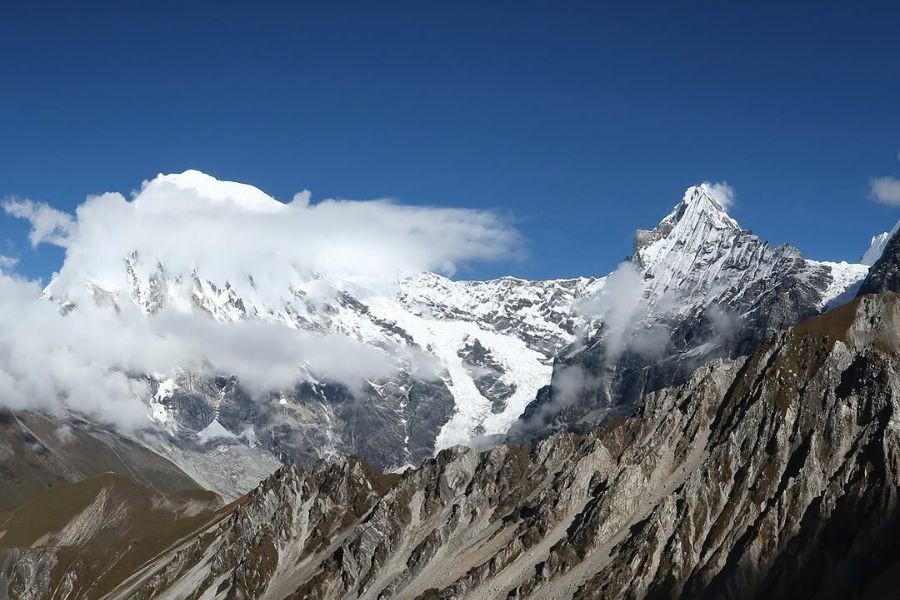
The Langtang Valley Trek in winter offers remarkable beauty and isolation, but there are also clearly challenges to be aware of and prepare for ahead of time. Understanding these challenges and planning accordingly will help to ensure a safe, comfortable, and enjoyable trek from start to finish.
Cold Temperatures: The biggest challenge of trekking in winter is the cold. Daytime temperatures at lower elevations will be somewhere in the range of 5°C - 10°C; however, in Kyanjin Gompa and above, nighttime temperatures will get down to -10 °C or -20°C or so. You must layer properly throughout the course of the day because you will be constantly regulating your body temperature as you will be warming up while you are trekking and cooling off while on meal breaks.
Snow Conditions: Fresh snow can make trails dangerous and more difficult to follow, especially above Langtang Village. Important stability comes from a trekking pole (poles), and really, if there is snow and ice, you will want to bring either microspikes or somewhat light crampons for your lower boots. Your guide working for Himalayan Ecological Trekking will assess snow conditions every day of the trek and change your route as necessary.
Reduced Daylight Hours: Daylight hours shorten in winter, and you can expect around 9-10 hours of daylight. Be prepared for early starts each day, and make sure you plan accordingly in order to reach your destination before it gets dark. Your guide will take care of the timing to make sure that you arrive safely at your nightly accommodation.
Potential Effects of Altitude: The altitude in Langtang is relatively moderate, but the altitude, along with the cold, can bring out altitude symptoms even sooner. Please pace yourself, drink plenty of water, and report any symptoms to your guide immediately. You should never push yourself through severe altitude symptoms. Your guide will know when to descend if necessary.
Tea House Availability: While most tea houses stay open during the winter months, some may close during the coldest few weeks of January. Himalayan Ecological Trekking will be able to update you on which lodges are in operation and can plan your itinerary accordingly.
Essential Safety Measures:
- Always trek with an experienced guide who knows winter conditions
- Carry extra warm layers and emergency supplies
- Stay hydrated even when you don't feel thirsty
- Protect exposed skin from frostbite and windburn
- Inform your guide about any health concerns immediately
- Have travel insurance that covers high-altitude trekking
With proper preparation and professional guidance, these challenges become manageable parts of your adventure rather than dangerous obstacles. Himalayan Ecological Trekking's expert teams have decades of winter trekking experience and prioritize your safety above all else.
FAQs: Langtang Valley Trek in Winter
How demanding is the Langtang Valley trek in winter from a physical standpoint?
The Langtang Valley trek is of a moderate challenge and is an excellent trip for reasonably fit trekkers without extensive experience of trekking at altitude. You will likely trek anywhere from 5 to 7 hours a day, slowly, continually gaining altitude. The winter will make trekking more difficult due to the cold temperatures and snowfall, but by following the proper preparation, reasonable pacing, and a good sleeping bag, it'll be possible for most people with an adventurous mindset.
How cold does it get in Winter in Langtang Valley?
Generally, daytime temperatures at lower elevations will be anywhere from 5ºC to 10ºC in winter, and trekking will not be an issue when the sun is shining. However, at Kyanjin Gompa and other higher altitudes, you can expect the temperature to drop to -10ºC to -20ºC at night. Make sure you pack the proper types of layers and a sleeping bag that accommodates the cold winter temperatures, and you will be fine.
Are the tea houses and lodges open in the winter?
Yes, the majority of the tea houses will be open along the main Langtang route. However, there may be limited tea houses during the coldest weeks in January, and some lodges will be closed. Himalayan Ecological Trekking will provide you with current lodge information and then organize your itinerary from there.
What is altitude sickness like in winter?
Altitude sickness can happen in any season, but cold conditions sometimes worsen the symptoms. The Langtang itinerary includes a gradual ascent with acclimatization time in Kyanjin Gompa. Stay well hydrated, ascend slowly, and communicate any symptoms to your guide immediately. Most trekkers acclimatize well to altitude sickness.
Is the Langtang Valley Trek safe after the earthquake in 2015?
Yes, the trek is completely safe. The trail is cleared, the villages have been rebuilt, and the tea house infrastructure has been restored. The local community has shown amazing resilience, and trekking here will aid the recovery from the earthquake. Himalayan Ecological Trekking is constantly monitoring all safety issues.
What permits will I need?
You need two permits: a TIMS (Trekker's Information Management System) card and a Langtang National Park entry permit. Your trekking agency will obtain these in Kathmandu before your departure. You will want to have access to these during the checkpoints on the trail.
How do I travel from Kathmandu to the trailhead?
To reach the trailhead at Syabrubesi, you can travel by jeep or local bus in approximately 7-8 hours from Kathmandu. While the road may be treacherous, you will be rewarded along the way with stunning scenery. As part of your trek packages, Himalayan Ecological Trekking offers comfortable private transportation.
What if I don't have winter gear and need to rent some in Kathmandu?
You'll be happy to know there are countless shops in the Thamel district of Kathmandu that rent good-quality trekking gear such as down jackets, sleeping bags, and boots. Himalayan Ecological Trekking can recommend trustworthy shops that undercut prices yet also provide high-quality equipment for rent.
Conclusion
The Langtang Valley Trek in Winter offers a true Himalayan trek with breathtaking natural beauty, genuine cultural interactions, and tranquility away from bustling tourist trails. Whether you are mesmerized by the sunrise over Langtang Lirung, attracted to snow-covered alpine forests, or looking forward to an opportunity for Tamang hospitality, with this trek, you are going to have a moment to be fond of forever.
Langtang Valley has a reasonable altitude, bright, clear winter skies, and, when partnered with the expert support of Himalayan Ecological Trekking, becomes an easier and safer choice for first-time Himalayan trekkers or experienced mountain lovers. When you are on trek, you are not merely experiencing natural beauty, but you are supporting resilient local communities that were rebuilt after the earthquake in 2015.
If you want to embrace the beauty and adventure of winter trekking, Langtang Valley awaits you with open arms. Start thinking about and planning your winter trip now and see why this valley is fast becoming the choice for those seeking authentic Himalayan trekking experiences.
Ready to Experience the Magic of Langtang Valley Trek in Winter?
Take advantage of professional advice and tailored support from Himalayan Ecological Trekking to ensure your trip is safe, comfortable, and distinctive. You can rely on them to use decades of winter trekking experience, professional guides, and a positive commitment to sustainable tourism in keeping your Langtang adventure safe and exceeding your expectations.
Contact us today to book your trek or get more information:
WhatsApp:+977 9851006023 (Bikesh)
Email: [email protected]
Start your Himalayan adventure now—your winter trekking dream is closer than you think
.jpg)



